
Change
In The Air
Step by step, the Nordic countries are
becoming renewable and sustainable energy societies and the landscape
is changing. Windmills account for 57% of Denmark’s electricity,
out the country’s total 66% energy realized from renewables.
Norway gets 98% from hydro electric power
plants and a few power percentages from windmills.
Sweden and Finland each realize between
50% respectively 16% of their electricity from hydro-electric power
plants.
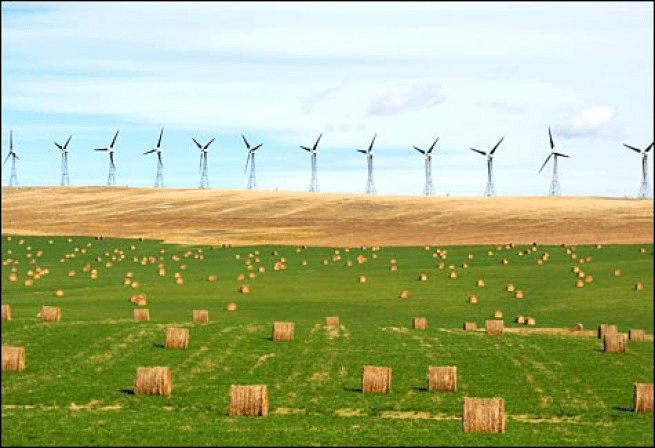 |
Where Rubber
Meets The Road
But for road transportation, the numbers
are generally modest, except for Norway that fields a 5.75% market-share
of electric cars in use today, followed by Iceland with almost 1% electric
cars; Sweden with 0.7%, and Denmark (regretfully) with only 0.30%.
But considering new sales, EVs are rapidly
gaining wider acceptance with Norway at 13.84%, followed by Iceland,
Sweden and Denmark.
Overall where the rubber meets the road,
Norway and Iceland are the Nordic Stars operating the largest numbers
of new generation vehicles and that number is growing.
The Numbers
Are Up
In 2014, roughly 85% of primary energy
use in Iceland was delivered from indigenous renewable resources; with
66% of that number realized from geothermal sources.
Those numbers are still very modest considering
road transportation accounts for only about only 695 EVs utilizing renewable
energy. But I’m very confident that the nature loving Icelanders
and their deep respect for nature shall convert quickly to EVs, once
4 wheel Cross Country EV cars becomes available at a competitive price.
Taking
To The Skies
So while the Nordic countries are moving
nicely towards renewables in general and especially reducing GHG and
CO2 emissions, the aviation industry needs to follow the general trend
– and they do!
Swedish
View on Sustainable Aviation
 According to Suvi Häkkinen of Swedavia
the company that operates the major airports of Sweden the future of
sustainable airports is the hot button topic right now.
According to Suvi Häkkinen of Swedavia
the company that operates the major airports of Sweden the future of
sustainable airports is the hot button topic right now.
“The aviation industry in Sweden
has a vision, ” Suvi assures.
“ In 2030, the corresponding amount
of sustainable aviation fuel (SAF) required to operate domestic flights
will be refueled at Swedish airports.
“Swedavia has a long-term commitment
to decrease fossil CO2 emissions and environmental impact from its own
operations and to support aviation's transition from fossil fuels to
SAF.
“Swedavia therefore actively supports
the development of SAF in Sweden and provide access to SAF at Swedavia’s
10 airports that take care of approximately 90 percent of all air traffic
in Sweden.
Putting
Money Where Mouth Is
 “Since 2016, Swedavia is buying
the same amount of SAF as is needed for the employee’s business
trips each year. The 450 tons of SAF are purchased via the Fly Green
Fund.
“Since 2016, Swedavia is buying
the same amount of SAF as is needed for the employee’s business
trips each year. The 450 tons of SAF are purchased via the Fly Green
Fund.
“By this action, Swedavia wants
to show decision-makers, companies and producers that already today,
there is both a demand for and a possibility to refuel with SAF in air
travel,” Suvi added, “in that way we can contribute toward
a more commercial market for SAF in Sweden and in the Nordics.”
Sustainability
of Aviation Biofuels
“It is important that SAF is being
used in a larger scale to show that it actually works. “At this
early stage, there is a need of a balanced approach between sustainability
parameters and what is technically and commercially possible,”
Suvi continued.
The Magic
Forest
“In Sweden, only as one example,
there are a lot of residuals from the forest industry that can be used
to produce SAF.
“In this case, the sustainability
parameters are probably met and the main hurdle is the financial aspect
to make it profitable.
“Economic incentives are needed
to improve scalability,” Suvi points out.
“As soon as there is a market for
SAF, the actual introduction in the system is easy compared to many
other energy consuming sectors.
“The global air fleet consists of
only around 25,000 aircraft with less than 2000 fuel filling stations.
“In Sweden alone, there are more
than 5 million cars and 2,000 filling stations for road vehicles (each
one handling at least three different kind of fuels) compared to 40
airports where only a handful are needed for all aviation fuel distribution.
“Since the fuel will be a drop-in
solution it can be used in current aircraft and with existing airport
infrastructure.”
Investment
Welcome
“Moving forward a certain percentage
of investment in green technology and governmental loan guarantees could
incentivize investments in SAF production. “It could also be valuable
to incentivize the use of current bio refineries to also produce SAF.
“This would in many cases probably
mean a less capital intensive way to produce SAF as long as we don’t
have a totally different production technology to produce this fuel.
“One way to increase the demand
of SAF could be to make it mandatory for all public authorities (government,
municipalities, regions etc.) to use SAF for their business trips according
to a similar model that is being used by Swedavia,” Suvi opined.
The Norwegian Perspective
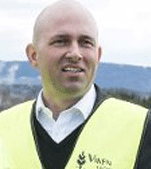 “The
Norwegian Perspective,” a government supported initiative, is
to reach 30% SAF by 2030.
“The
Norwegian Perspective,” a government supported initiative, is
to reach 30% SAF by 2030.
Olav Mosvold Larsen, Senior Executive
Adviser, Avinor – managing sustainability initiatives at 45 airports
in Norway has some thoughts.
“Organizations from the Norwegian
aviation industry joined forces to look into what must be done to reduce
greenhouse gas emissions. “At the moment, fleet renewal and investments
in new technology would make the biggest contributions towards reducing
environmental emissions.
“To reduce emissions even further,
sustainable biofuels will have to replace today’s fossil-based
fuel.
“A new report from Rambøll
shows that 30% or 400 million liters of all aviation fuel used at Avinor's
airports could be sustainable by 2030.
“This fuel could be produced from
forestry waste and pulpwood from Norwegian forests.
“All the parties involved in Norwegian
aviation must share responsibility to reduce greenhouse gas emissions.
“It is extremely good news that
it will be possible to achieve a 30% cut in emissions thanks to large-scale
investment in sustainable biofuels.
Other Voices
 “The increase in production would
also create new businesses and jobs in Norway, ”said Dag Falk-Petersen,
(leftt) CEO of Avinor.
“The increase in production would
also create new businesses and jobs in Norway, ”said Dag Falk-Petersen,
(leftt) CEO of Avinor.
“At the moment, very little sustainable
biofuel is produced on a global scale and the small amount available
is not priced competitively.
“This means that achieving the target
of a 30% blend, and the corresponding cut in emissions, would only be
possible with the help of public funding.
“The authorities and politicians
will have to facilitate large-scale investment in the commercial production
of biofuel in Norway, with financial incentives that work. “The
environmental charges currently paid by the airlines would have to be
used for activities that benefit the climate.
“This would allow us to create a
commercial market for the production of biofuel for aviation as quickly
as possible,” Falk-Petersen said.
“The sustainable biofuel initative
would also have to go to those sectors of the aviation industry which
currently have no other technological alternatives,” said Torbjørn
Lothe, (below right) Director General of the Federation of Norwegian
Aviation Industry.
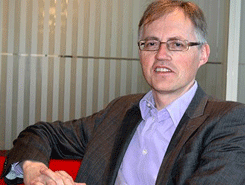 “The Rambøll report outlines
two detailed models that could finance the production of sustainable
biofuel for aircraft in Norway. “This is how the first would work:
“The Rambøll report outlines
two detailed models that could finance the production of sustainable
biofuel for aircraft in Norway. “This is how the first would work:
•
The airlines continue to pay the same charges as they do now.
•
The money goes into a fund.
•
The airlines subscribe to the fund.
•
The fund pays the additional costs required to blend the biofuel into
the mix
•
Producers sell through contracts signed with the airlines.
“An alternative model is for a similar
fund to be responsible for drawing up purchase agreements for biofuel
on behalf of the airlines.
“The fund could initiate a tender
process and invite bids to supply a given number of liters of fuel for
a specified period. The fund would achieve economies of scale and better
contracts than if the airlines worked independently.
“The fund system could help the
Norwegian aviation industry to reduce greenhouse gas emissions by 30%
by 2030.
“It would also have a knock-on effect
in terms of emissions trading allowances, and would achieve reductions
in other sectors.
“We have outlined the options, and
now it is up to the authorities and politicians to turn the aviation
industry’s green initiative into reality,” said Lothe.
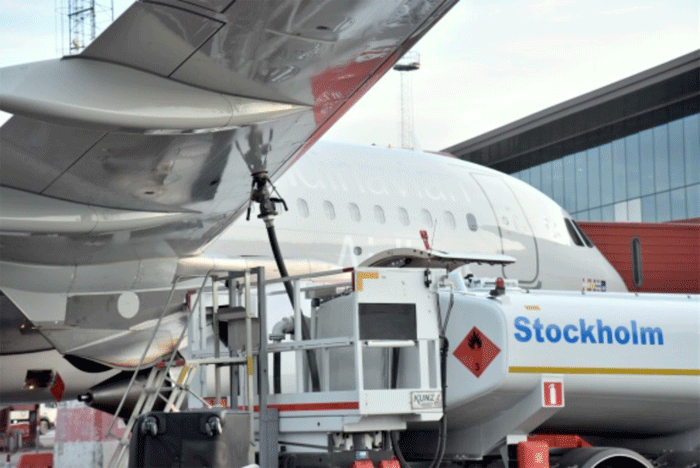 |
A Postcript
& Further Reading
The objective of the Rambøll report
was to look at access to sustainable fuel and new, certified production
technologies.
Another important task was to evaluate
what funding would be required to phase in sustainable biofuel for aircraft
at Norwegian airports.
The study was conducted by Rambøll,
with the assistance of Vista Analyse and Sintef. The project’s
steering group included representatives from Avinor, Norwegian, SAS
and the Federation of Norwegian Aviation Industries.
Regular steering group meetings were held
throughout the study.
A range of other organizations were also
invited to workshops and meetings; these included potential producers
of bio jet fuel, funding agencies, environmental organizations and other
special-interest organizations.
The Avinor and Norwegian initiative was
presented by Tove Kristin Flølo, Director General, The Norwegian
Ministry of Transport and Communication in the Nordic Leadership in
Aviation Emission Reductions Conference.
Nordic Leadership
in Aviation Emission Reductions Conference
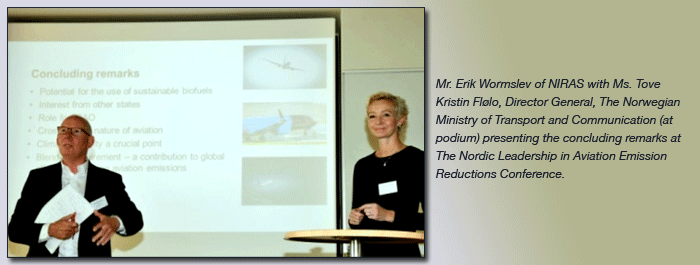 |
An ambitious statement! –
Yes, but without ambitious ambitions, you might not reach your target!
So with that in mind and to aim for the
top, aviation stakeholders met in Copenhagen to formulate ambitious
goals for a transition from fossil fuels to sustainable aviation energy
sources in the Nordic countries. - The meeting was hosted by Copenhagen
Airports and organized by Nordic Energy Research (a platform for cooperative
energy research and policy development under the auspices of Nordic
Council of Ministers) and NISA – Nordic Initiative for Sustainable
Aviation).
The meeting was supported and had the
participation of IATA, Boeing and Airbus and was moderated by Mr. Erik
Wormslev of NIRAS, an international consulting group that also produced
the report Norden, Sustainable jet fuel for aviation; more precisely
“Nordic perspectives on the use of advanced sustainable jet fuel
for aviation,” click for more here.
The Nordic Conference – Nordic
Leadership in Aviation Emission Reductions - made the following conclusions.
Here are the key observations!
1. Include
aviation in National Energy Plans for EU (winter package) /RED 2- (and
EFTA-countries).
2. Encourage
corporate, private and public use of sustainable jet fuels.
3. Include
sustainable jet fuel in public procurement with sustainability criteria
(military fuel) and public entities (flights).
4. Explore
opportunities for public-private partnerships to establish best possible
conditions for funding, pilot/demo plants a.m.
5. Develop
a Nordic pre-qualification- or tender process for sustainable jet fuels
6. Give
high priority to negotiations on aviation and climate issues in international
bodies such as ICAO, ECAC and EU
The agenda, as well as the presentations
from the conference: "Nordic leadership in aviation emissions reductions"
Copenhagen Airport 10th October 2017: - is available at the following
link.
Robert Arendal
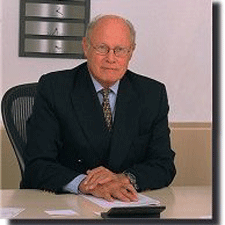 Air
cargo pioneer, dreamer, and doer Robert Arendal has over 45 years
of experience in the air cargo industry, occupying various shipping
and air cargo management positions in Europe as well as the U.S.
In 1970 he became part of the management team that founded Cargolux
Airlines International SA, spending 29 years as Senior Vice President
Sales, Marketing and Cargo Services as well as Deputy CEO. Air
cargo pioneer, dreamer, and doer Robert Arendal has over 45 years
of experience in the air cargo industry, occupying various shipping
and air cargo management positions in Europe as well as the U.S.
In 1970 he became part of the management team that founded Cargolux
Airlines International SA, spending 29 years as Senior Vice President
Sales, Marketing and Cargo Services as well as Deputy CEO.
Mr. Arendal is a founding father and
first Chairman of TIACA (The International Air Cargo Association).
He is a past President and presently a member of TIACA's President
Council and entered the legendary TIACA Hall of Fame in 1997.
He is co-founder of the Cool Chain
Association and has been its chairman for 10 years.
More recently, Mr. Arendal became
a founding member of the ‘Sustainable Biofuel Network,’
a group of stakeholders facilitating aviation’s transition
from fossil fuels to sustainable and renewable alternative biofuels. |



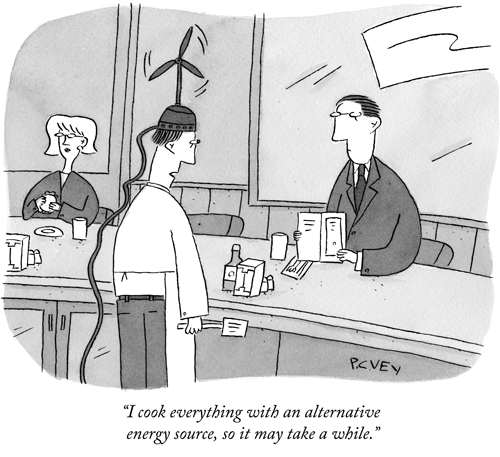
 Qatar
Cargo QEP Cool
Qatar
Cargo QEP Cool
 Vol.
17 No. 2
Vol.
17 No. 2 Vol.
17 No. 3
Vol.
17 No. 3